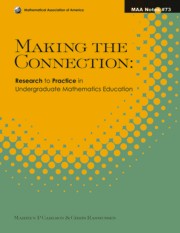Book contents
- Frontmatter
- Preface
- Contents
- Part 1 Student Thinking
- 1a Foundations for Beginning Calculus
- 1b Infinity, Limit and Divisibility
- 5 Developing Notions of Infinity
- 6 Layers of Abstraction: Theory and Design for the Instruction of Limit Concepts
- 7 Divisibility and Transparency of Number Representations
- 1c Proving Theorems
- 8 Overcoming Students' Difficulties in Learning to Understand and Construct Proofs
- 9 Mathematical Induction: Cognitive and Instructional Considerations
- 10 Proving Starting from Informal Notions of Symmetry and Transformations
- 11 Teaching and Learning Group Theory
- 12 Teaching for Understanding: A Case of Students' Learning to Use the Uniqueness Theorem as a Tool in Differential Equations
- Part 2 Cross-Cutting Themes
- About the Editors
8 - Overcoming Students' Difficulties in Learning to Understand and Construct Proofs
from Part 1 - Student Thinking
- Frontmatter
- Preface
- Contents
- Part 1 Student Thinking
- 1a Foundations for Beginning Calculus
- 1b Infinity, Limit and Divisibility
- 5 Developing Notions of Infinity
- 6 Layers of Abstraction: Theory and Design for the Instruction of Limit Concepts
- 7 Divisibility and Transparency of Number Representations
- 1c Proving Theorems
- 8 Overcoming Students' Difficulties in Learning to Understand and Construct Proofs
- 9 Mathematical Induction: Cognitive and Instructional Considerations
- 10 Proving Starting from Informal Notions of Symmetry and Transformations
- 11 Teaching and Learning Group Theory
- 12 Teaching for Understanding: A Case of Students' Learning to Use the Uniqueness Theorem as a Tool in Differential Equations
- Part 2 Cross-Cutting Themes
- About the Editors
Summary
When a topologist colleague was asked to teach remedial geometry, he used Schaum's Outline of Geometry and also wrote proofs on the blackboard. One day a student, who was familiar with two-column proofs having statements such as ΔABD ≅ ΔBCD and reasons such as SAS, blurted out in utter surprise, “You mean proofs can have words!”
This geometry student's previous experience had led him to an unfortunate view of proof. Other students experience epiphanies about themselves and proof. Asked what she (personally) got out of a transition-to-proof course, one of our students answered, “I learned that I could wake up at 3 A.M. thinking about a math problem.”
What do responses like this tell us? Almost all undergraduate mathematics courses are about the concepts and theorems of mathematics — when a matrix has an inverse, how to find it, and when to use it; when a series converges; the distinction between continuous and uniformly continuous; the meaning of compact. However, students in courses like abstract algebra, real analysis, and topology normally demonstrate their competence by solving problems and proving theorems. And, if students go beyond a few lower-division courses such as calculus or first differential equations, this usually involves constructing original proofs or proof fragments. But, often not much time can be devoted to helping students learn how to construct proofs. This might not lead to difficulties, if only students came to university understanding something about the nature of proof and already had some experience constructing simple proofs.
- Type
- Chapter
- Information
- Making the ConnectionResearch and Teaching in Undergraduate Mathematics Education, pp. 95 - 110Publisher: Mathematical Association of AmericaPrint publication year: 2008
- 20
- Cited by



